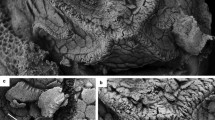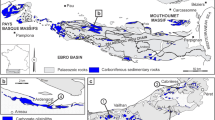Abstract
The study of the morphology of the rugose corals and the acception of a solitary sessil sexual polyp, as the stem form of the Anthozoa (B. WERNER) lead to the conclusion that the stem form of the rugose corals was a solitary sessil polyp without a base disc and with four or more pairs of mesenteries from which two were directive pairs. Therefore it seems correct to supply the name Rugosa by Tetracorallia Haeckel 1866.
The evolution of the Auloporida from such a stem form follows another trend, which is characterised by the development of colonies. It seems possible, that this trend was attented with the reduction and the lost of the four mesenteries of the hypothetic stem form. Therefore it is not sure, that the Auloporida belong to the Anthozoa.
Kurzfassung
Ausgehend von der Skelettmorphologie der Rugosa und der Vorstellung einer polypoiden tetrameren Ausgangsform der Anthozoa führen theoretische Überlegungen zur Annahme einer polypoiden Ahnenform der Rugosa ohne Fußscheibe und mit mindestens vier Mesenterienpaaren, von denen zwei als Richtungsmesenterien ausgebildet gewesen sein dürften. Von derartigen Formen können die Tabulata (Auloporida) nicht abgeleitet werden. Sie stellen eine völlig getrennte Entwicklungsrichtung dar, die durch Koloniebildung charakterisiert ist. Es wäre möglich, daß ihrem Weichkörper Mesenterien fehlten. Daher erscheint es nicht gesichert, daß sie systematisch den Anthozoa zuzuordnen sind. Dies führt zur Frage der Gliederung der Anthozoa sowie zu dem Vorschlag, den älteren Namen Rugosa durch den der Morphologie besser gerecht werdenden Namen Tetracorallia HAECKEL 1866 zu ersetzen.
Similar content being viewed by others
Literatur
Birenheide, R. (1965): Haben die rugosen Korallen Mesenterien gehabt?. - Senckenb. Lethaea,46: 27–34; Frankfurt.
Bourne, M. A. (1900): Class Anthozoa. - [In:]Lankester, E. r. (Ed.): A treatise on Zoology. -II., 84 S.; London (Adam & Charles Black).
Chapman, D. M. (1966): Evolution of the Scyphistoma. - [In:]Rees, W. J. (Ed.): The Cnidaria and their Evolution.- Symp. Zool. Soc. London,16: 51–75; London.
Cloud, P. &Glaessner, M. F. (1982): The Ediacarian Period and System: Metazoa Inherit the Earth.-Sci.,217: 783–792; Washington.
Flower, R. H. (1961):Montoya and related colonial corals. - New Mexico State Bur. Mines Miner. Resour., Mem 7: 13–52; Socorro.
Flugel, H. W. (1975): Skelettenentwicklung, Ontogenie und Funktionsmorphologie rugoser Korallen. -Paläont. Z.,49: 407–431; Stuttgart.
— (1976): Ein Spongienmodell für die Favositidae. - Lethaia,9: 405–419; Oslo.
— (1980): Einige Notizen zur Phylogenie der Rugosa. - Ann. Naturhist. Mus. Wien,83: 73–82; Wien.
Haeckel, E. (1866): Generelle Morphologie der Organismen. [In:]Reimer, G. (Ed.): Allgemeine Entwicklungsgeschichte der Organismen,2: 53–56; Berlin.
Hand, C. (1966): On the evolution of the Actiniaria. - [In:]Ress, W. J. (Ed.): The Cnidaria and their Evolution. - Symp. Zool. Soc. London,16: 135–146; London.
Hill, D. (1960): Possible intermediates between Alcyonaria Tabulata, Tabulata and Rugosa, and Rugosa and Hexacoralla. - Internat. Geol. Congr., XXI Session, Norden, 51–58; Copenhagen.
- (1981): Treatise on Invertebrate Paleontology. - Coelenterata Part F, Geol. Soc. Am. Inc., 378 S.; Kansas.
Kaljo, D. L. (1960): Nekotorye voprosy razvitija ordovikskikh tetracorallov. - Tr. Geol. Inst. An Est. SSR,5: 245–258.
Kazmierczak, J. (1984): Favositid Tabulates: Evidence for Poriferan Affinity. - Science,225: 835–837; Washington.
Ma, T. Y. H. (1933): On the seasonal change of growth in some Palaeozoic corals. - Imp. Acad. Proc,9: 407–409.
Petersen, W. W. (1979): Development of Coloniality in Hydrozoa. - [In:]Larwood, G. &Rosen, B. R. Biology and Systematic of Colonial Organisms. - Syst. Ass. Spec.11: 105–139; London.
Schmidt, H. (1974): On evolution in the Anthozoa. - Proc. Soc. Int. Coral Reef Symp.,1: 533–560; Brisbane.
Scrutton, C. T. (1979): Early fossil Cnidarious. - [In:] HOUSE (Ed.): The Origin of Major Invertebrate Groups. - System. Ass. Spec.12: 161–207; London.
Shelton, G. A. B. (1979): Co-ordination of Behaviour in Cnidarian Colonies. - Syst. Ass. Spec.11: 141–153; London.
Sokolov, B. S. (1955): Tabulyaty paleozoya evropeyskoy chasti SSSR, Vvedenie: Obshchie voprosy sistematiki i istorii razvitiya tabulyat: Vses. Neft. Nauchnoissled. - Geol. Razved. Inst. (VNIGRI),85: 527 S.; Moskau.
- (1962): Gruppa Chaetetida, podklass Tabulata, podklass Heliolitoidea. - [In:] ORLOV, YU. A. (Ed.): Osnovy paleontologii, II: 169-178; Moskau.
Sytova, V. A. (1977): On the origin of Rugose corals. - Mem. B. R. G. M.,89: 65–68; Paris.
Thiel, H. (1966): The evolution of Scyphozoa a review. - [In:] RESS, W. J. (Ed.): The Cnidaria and their Evolution. - Symp. Zool. Soc. London,16: 77–177; London.
Uchida, T. (1969): The interrelationships of Scyphozoan class. - Bull. Mar. Biol. Stat. Asumushi, Tohoku Univ.,13: 247–250; Tohoku.
Webby, B. D. (1971): The new Ordovician genusHillophyllum and the early history of rugose corals with acanthine septa. -Lethaia,4: 153–168; Oslo.
Wells, J. W. &Hill, (1956): Anthozoa - general features. - [In:]Moore, R. C. (Ed.): Treatise on Invertebrate Paleontology. -Coelenterata Part F., Geol. Soc. Am., 161–165; Kansas.
— (1967): Morphologie, Systematik und Lebensgeschichte vonStephanoscyphus (Scyphozoa Coronatae) sowie seine Bedeutung für die Evolution der Scyphozoa. - Verh. dt. zool. Ges., Zool. Anz. Suppl.,30: 297–319; Göttingen.
— (1970): Weitere Untersuchung über die Entwicklungsgeschichte vonStephanoscyphus (Scyphozoa Coronatae) und seine Bedeutung für die Evolution der Scyphozoa. - Zool. Anz. Suppl,33, Verh. Zool. Ges., 1969, 159–165; Göttingen.
— (1971): Neue Beiträge zur Evolution der Scyphozoa und Cnidaria. - Acta Salmant. (Ciencias), {BD36} (1969): 223–244; Salamanca.
— (1973): New investigations on systematics and evolution of the class Scyphozoa and evolution of the class Scyphozoa and the Phylum cnidaria. - Publ. Seto Marin. Biolog. Labor,20: 35–61; Brisbane.
Werner, B. (1979): Coloniality in the Scyphozoa: Cnidaria. - In:Larwood, G. &Rosen, B. R.: Biology and Systematic of Colonial Organisms. - Syst. Ass. Spec. 11, 81–103; London.
Weyer, D. (1972): Zur Morphologie der Rugosa (Pterocorallia). - Geologie,21: 710–738; Berlin.
Weyer, D. (1973): ßber den Ursprung der Calostylidae ZITTEL 1879 (Anthozoa Rugosa, Ordoviz-Silur). -Freiberger Forsch.-H. C282: 23–87; Leipzig.
— (1974): Das Rugosa-GenusAntiphyllum SCHINDEWOLF, 1952 (Unternamur, Oberschlesisches Steinkohlenbecken). -Casopis pro mineralogii a geologii,19: 345–365; Prag.
— (1979): ZweiUfimia-Arten aus dem Erdbacher Kalk im Rheinischen Schiefergebirge (Anthozoa, Rugosa; Unterkarbon). - Abh. Berg. Naturkd. Vorgesch.,2: 3–25; Magdeburg.
— (1980): Die älteste rugose Koralle Europas. - Wissenschaftl. Beitr. Martin-Luther Univ., Halle/Wittenberg,30: 51–77; Halle.
Author information
Authors and Affiliations
Rights and permissions
About this article
Cite this article
Flügel, H.W. Abstammung und systematische Stellung der Rugosa und Auloporida. Paläont. Z. 59, 201–210 (1985). https://doi.org/10.1007/BF02988808
Published:
Issue Date:
DOI: https://doi.org/10.1007/BF02988808




